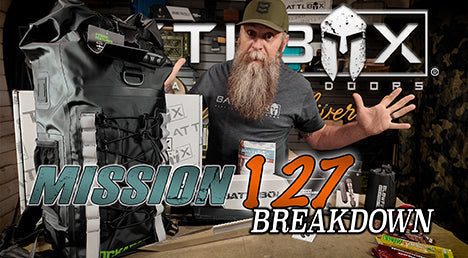Battlbox
What is Bikepacking? A Comprehensive Guide to the Adventurous Journey
Table of Contents
- Introduction
- Defining Bikepacking: What It Is and Its History
- Bikepacking vs. Bicycle Touring: Understanding the Differences
- Essential Gear for Bikepacking: What to Pack
- Planning Your First Bikepacking Trip: Tips and Tricks
- Exploring Popular Bikepacking Routes
- The Community and Culture of Bikepacking
- Conclusion: Embrace the Adventure
- Frequently Asked Questions (FAQ)
Introduction
Imagine the thrill of pedaling through breathtaking landscapes, the wind against your face, and the freedom of the open road stretched before you. Now, combine that with the adventure of exploring the great outdoors overnight, camping under the stars, and carrying everything you need on your bike. This exhilarating experience is known as bikepacking, a captivating blend of cycling and backpacking that allows enthusiasts to venture into remote territories and discover hidden gems off the beaten path.
Bikepacking has surged in popularity over the past decade, with outdoor enthusiasts eager to embrace this unique form of adventure travel. Whether you are a seasoned cyclist or a beginner looking to explore, bikepacking offers something for everyone. In this comprehensive guide, we will delve into what bikepacking really is, how it differs from traditional bicycle touring, the essential gear needed, and tips for planning your first bikepacking trip. By the end, you will have a solid understanding of how to embark on your own bikepacking journey.
This blog post will cover the following topics:
- Defining Bikepacking: What It Is and Its History
- Bikepacking vs. Bicycle Touring: Understanding the Differences
- Essential Gear for Bikepacking: What to Pack
- Planning Your First Bikepacking Trip: Tips and Tricks
- Exploring Popular Bikepacking Routes
- The Community and Culture of Bikepacking
- Conclusion: Embrace the Adventure
- Frequently Asked Questions (FAQ)
Let’s dive into the world of bikepacking and explore the adventure that awaits!
Defining Bikepacking: What It Is and Its History
At its core, bikepacking is an adventurous fusion of cycling and backpacking. It involves carrying the essential gear needed for overnight or multi-day trips on a bike that is capable of traversing a variety of terrains. Bikepacking allows riders to explore off-road trails, gravel paths, and scenic backroads while enjoying the freedom and excitement of cycling.
The roots of bikepacking can be traced back to the late 1980s when adventurous cyclists began using mountain bikes for long-distance travel. The term "bikepacking" gained popularity through the rise of endurance races and the development of specialized bikepacking gear, such as lightweight bags and frame-mounted storage solutions. These innovations allowed riders to carry their gear without the cumbersome racks and panniers traditionally associated with bicycle touring.
Bikepacking has evolved significantly since its inception, with a growing community of riders embracing it as a means to connect with nature and explore the world in a more immersive way. Today, bikepacking routes span across continents, inviting cyclists to experience diverse landscapes and cultures like never before.
Bikepacking vs. Bicycle Touring: Understanding the Differences
While bikepacking and bicycle touring share similarities, they cater to different experiences and preferences. Understanding these distinctions can help you choose the best approach for your cycling adventures.
Focus on Terrain
The most notable difference lies in the terrain. Bikepacking primarily involves off-pavement riding, incorporating dirt roads, trails, and gravel paths. This focus on mixed surfaces allows bikepackers to immerse themselves in nature and enjoy a more rugged experience. Conversely, bicycle touring typically emphasizes paved roads, making it more suitable for those who prefer a smoother ride.
Gear and Setup
Bikepacking gear is designed to be lightweight and streamlined, focusing on efficiency and minimalism. Riders often use soft bags that attach directly to the bike, such as frame bags, seat packs, and handlebar bags. This setup allows for better weight distribution and maneuverability on challenging terrains.
In contrast, bicycle touring usually involves a heavier setup with traditional racks and panniers, which can add weight and impact handling. While both approaches require careful packing, bikepacking gear tends to prioritize a minimalist philosophy, allowing for a more agile ride.
Route Planning
Bikepacking routes are often less structured, encouraging exploration and spontaneity. Riders may choose to navigate off the beaten path, creating their own routes based on personal interests and discoveries. This flexibility promotes a sense of adventure and the opportunity to connect with nature in a more meaningful way.
Bicycle touring, on the other hand, often involves planned routes with established campsites and amenities along the way. Tourists may follow designated bike paths or scenic highways, focusing on the journey rather than the destination.
Essential Gear for Bikepacking: What to Pack
Packing for a bikepacking trip requires careful consideration and a focus on lightweight, functional gear. Here’s a breakdown of the essential items you’ll need for a successful bikepacking adventure.
1. The Right Bike
Choosing the right bike is crucial for a successful bikepacking trip. While mountain bikes are a popular choice due to their versatility and durability, gravel bikes and even hybrid bikes can also work well. Consider the type of terrain you plan to ride on and choose a bike that is capable of handling it.
2. Bikepacking Bags
Investing in quality bikepacking bags is essential for a streamlined ride. The following bag types are commonly used:
- Frame Bag: Fits inside the main triangle of the bike frame and is ideal for storing heavier gear.
- Seat Pack: Attaches to the seat post, providing extra storage for lightweight items.
- Handlebar Bag: Mounts to the handlebars and is perfect for easy access to snacks, maps, and other essentials.
- Top Tube Bag: Mounted on the top tube of the bike, this bag is great for quick access to items like your phone and energy bars.
3. Sleeping Gear
A lightweight sleeping system is vital for overnight trips. This typically includes a compact sleeping bag, sleeping pad, and a tent or tarp. Consider options that are easy to pack and set up, allowing for a comfortable night’s sleep under the stars.
4. Cooking Equipment
While some bikepackers prefer to cook their meals, others may opt for simple, no-cook meals to minimize gear. If you plan to cook, consider a lightweight stove, fuel, and cooking utensils. Don’t forget to pack a portable water filter or purification tablets to ensure access to clean drinking water.
5. Clothing and Personal Items
Pack clothing that is appropriate for the weather conditions and terrain. Layering is key, allowing you to adjust your clothing as temperatures change. Include a rain jacket, comfortable cycling shorts, and moisture-wicking base layers. Don’t forget essentials like a first aid kit, sunscreen, and toiletries.
6. Navigation and Safety Gear
Ensure you have the necessary navigation tools, such as a map, compass, or GPS device. A multi-tool can be invaluable for on-the-go repairs, while a whistle, headlamp, and reflective gear enhance safety during your adventure.
Planning Your First Bikepacking Trip: Tips and Tricks
Embarking on your first bikepacking trip can be both exciting and daunting. Here are some tips to help you plan effectively and enjoy a successful journey.
1. Choose a Short Route
For your first bikepacking experience, select a short and manageable route. Aim for a distance of 10-20 miles (15-30 kilometers) that is familiar to you. This allows you to focus on the experience without the added stress of navigating unknown territory.
2. Keep It Simple
When packing for your initial trip, simplicity is key. Avoid overpacking and focus on the essentials. Consider preparing easy-to-carry meals, such as pre-packaged snacks or wraps. This will allow you to enjoy your trip without the burden of complex cooking.
3. Familiarize Yourself with Gear
Before heading out, familiarize yourself with your gear and how to set it up. Practice loading your bike, adjusting your bags, and setting up your campsite. This will help you feel more confident and prepared on the day of your trip.
4. Plan for Resupply
If your route allows, plan for resupply points along the way. This could be a town where you can restock food, water, or other essentials. Having a backup plan in case of emergencies is always a good idea.
5. Evaluate After Your Trip
Once you return from your trip, take time to evaluate what worked and what didn’t. Consider aspects like your gear choice, route planning, and overall experience. This reflection will help you improve your future bikepacking adventures.
Exploring Popular Bikepacking Routes
As bikepacking continues to grow in popularity, numerous routes have emerged, each offering distinct landscapes and experiences. Here are a few popular bikepacking routes worth exploring:
1. The Great Divide Mountain Bike Route (GDMBR)
Stretching over 2,700 miles from Canada to Mexico, the GDMBR is one of the most iconic bikepacking routes in the world. It takes riders through stunning mountain landscapes, remote wilderness areas, and charming small towns. This route offers a true test of endurance, making it ideal for experienced bikepackers.
2. The Arizona Trail
The Arizona Trail spans approximately 800 miles, showcasing the diverse terrains of Arizona, from deserts to mountains. This route offers a mix of challenging singletrack and gravel roads, making it perfect for adventurous cyclists seeking a rugged experience.
3. The Oregon Timber Trail
This newer route weaves through the stunning landscapes of Oregon, featuring lush forests, mountain views, and scenic rivers. The Oregon Timber Trail is a fantastic option for those looking to explore the Pacific Northwest on two wheels.
4. The Colorado Trail
The Colorado Trail offers breathtaking views of the Rocky Mountains, covering over 500 miles of diverse terrain. The route is popular among mountain bikers and bikepackers alike, providing a mix of technical singletrack and more accessible paths.
The Community and Culture of Bikepacking
Bikepacking is not just about the journey; it’s also about the community that comes with it. Enthusiasts from all walks of life share a passion for adventure and exploration. Online forums, social media groups, and local meet-ups provide opportunities for riders to connect, share tips, and inspire one another.
Participating in bikepacking events and races can also foster a sense of belonging within the community. These gatherings often feature workshops, gear demos, and group rides, creating an inclusive atmosphere for riders of all skill levels.
Conclusion: Embrace the Adventure
Bikepacking is more than just a mode of travel; it’s an exhilarating way to connect with nature, explore new terrains, and challenge yourself physically and mentally. With the right gear, proper planning, and a sense of adventure, you can embark on a journey that will leave you with unforgettable memories and a deeper appreciation for the great outdoors.
As you consider your own bikepacking adventures, remember that Battlbox offers a selection of high-quality outdoor and survival gear tailored for your needs. Explore our Battlbox Shop for essential bikepacking gear and check out our subscription services to keep you equipped for your next adventure:
Now is the time to embrace the adventure of bikepacking and discover the world on two wheels. Get ready, pack your bags, and hit the trail!
Frequently Asked Questions (FAQ)
What is the difference between bikepacking and bicycle touring?
Bikepacking involves off-pavement riding and focuses on a lightweight, minimalist approach to gear, while bicycle touring typically emphasizes paved roads and a more structured setup with racks and panniers.
Do I need a specific type of bike for bikepacking?
While mountain bikes are popular for bikepacking, gravel bikes and hybrid bikes can also work well. The key is to choose a bike that is capable of handling the terrain you plan to ride on.
What gear should I pack for my first bikepacking trip?
Essential gear includes a suitable bike, bikepacking bags, sleeping gear (sleeping bag, pad, tent), cooking equipment (if desired), clothing, and navigation tools. Keep it simple and focus on the essentials.
Are there beginner-friendly bikepacking routes?
Yes! Look for shorter routes that you are familiar with, ideally around 10-20 miles, as these will allow you to focus on the experience without the stress of navigating unknown territory.
How can I connect with the bikepacking community?
Online forums, social media groups, and local meet-ups are great ways to connect with fellow bikepackers. Participating in events and races can also help you build connections within the community.
By understanding what bikepacking is and how to prepare for it, you can embark on an adventure that opens up a world of exploration and excitement.
Share on:
























